Differentiate or Die
RECOLLECTION issue 1

by Newscopy/G*P - editor, Propaganda
A study of the evolution of magazines in scene town
In an average newsstand, the consumer faces a selection of 300 magazines. For editors and marketers, differentiating and finding the right niche is key.
How have differentiations influenced the magazine market on the scene and what influence have the magazines had on the scene to become what it is today?
Little did we understand when we started copying games that we were giving birth to our own replica of society. Slamming intros in front of games developed the first well-known trademarks in our scene and minds. Groups were like consumer corporations becoming brands with different values and meanings in our mind. We organized ourselves and mobilized our armies. The scene had become a life of its own.
In a very short time we had set our own laws and rules to obey. We had established social structure and hierarchies (elite/lame), distribution (swappers/traders/boards) and brands (groups/people). In this artificial world you could either be part of the business, or enjoy the entertainment (demos).
It took up until 1986 before the amount of information that was produced by the scene society needed a filter and reporting function.
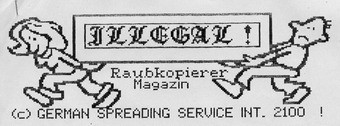
ILLEGAL, edited by Jeff Smart, was the first magazine. It rapidly became a strong, influential voice. Illegal was produced on paper, which limited its distribution. If you were one of the lucky ones (read elite) you would get your hands on a copy. If you were sufficiently in touch with a remote elite citizen of the scene, you would receive a copy of a copy of a copy of an Illegal. By then the magazine would be old and out of date. This was the first known and relevant media in our history.
Production was poor with today's standards, and the time to market even worse. By the time the news were in print and reached its readers, the news would already have been distributed with paper notes in regular disk sendings, over phone conferences or through subs on the first American boards.
What was interesting to observe was the power and influence Illegal achieved. Groups and people were concerned what was being written about them - being cool was always a key issue in the scene. The Illegal boosted competition among groups by establishing charts. This had not existed before. This would trigger groups to work even harder on the releases, fine-tuning distribution and enhancing their image. Being covered in a magazine meant that PR (public relations) would become an important tool to look cool or good in the public eye. This was unheard of before. You may be a very qualified group in bringing out good or fast releases but if the people behind it weren't making any noise or being interesting, who cared? Who would you rather read about Genesis*Project(strong profile, lots of noise) or Transcom (no profile, no noise)? Groups were becoming brands. Jeff Bezos, Amazon CEO once said "Ultimately, a brand is what the people say about you when you're not there.", and what better place to plant a seed in people's mind than through magazines - except for maybe through a cocky scroll text in an intro?
For me it is obvious, that it was not until the birth of the Illegal, that the scene, its structure and society as we know it, was firmly established and documented. This is and will always be Illegal's contribution to our history despite its limited distribution.
New channels open new doors.
It is remarkable that it would take until 1988 until Sex N Crime (AMOK) would revolutionize the market by opening a new distribution channel that would secure a much larger target group; by disk. It may seem an obvious step today but it you have to imagine that it was not until 1988 that the channels of distribution had been firmly established through well-organized swapper channels that could manage pan-European or even global distribution. It was a time when mega-swappers secured successful spreading.
Disk magazines opened up many new doors:
- News could travel more widely to a wider audience.
- News would be newer than on paper
- Production was cheap and required only someone to make the source.
- Contact-addresses to groups and people became instantly accessible through "Contact"-chapters
- Slowly the scene was helped to go from pan-European to global (this would be further increased through the explosion of American boards a year later)
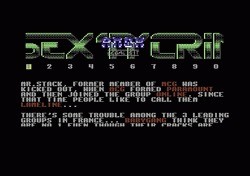
Sex N Crime opened up the scene to a new world that would never be the same. It was a wake-up call to the people spending time in front of the Commodore 64 that they were actually part of a digital society - a scene town. Not only the elite were citizens.
What is known in the corporate world as the "me-too"-phenomenon occurred in the scene. Everybody wanted a piece of the pie and to channel a voice. Disk magazines flourished the scene. Towards the end of 1988, there were more than 15 magazines on the scene. The summer of 1989 there were 35. Characteristically, the "me-too"-phenomenon gave birth to magazines that would successfully take market share from Sex N Crime. The "me-too" phenomenon produces weak copies but also innovators and niches.
McDonald's pioneered fast food. Pizza Hut, KFC, Dunkin Donuts and all others were typical followers or "me-too's". There is a piece of the pie for everyone and plenty of room for franchise. Find your niche (Pizza, chicken or whatever) or become an innovator (Starbucks).
In the many attempts to take Sex N Crime's role, some prominent productions took the media landscape further. Sex N Crime, still with a first mover advantage suffered greatly in maintaining reader preference. Who would be the clear followers, the niche or the innovators?
In its inability to adapt and renew its offer, Sex N crime was put on the shelf. It was taken over by leaders in several different areas.
There is nothing strange with this. Any product has a life cycle. The black and white TV had tremendous growth, reached a peak and was replaced by the color TV. The same will happen to VCR's over DVD's. Products have to make room for improvement. Magazines too.
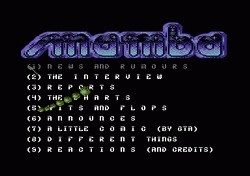

There are no actual figures of members of the scene community - but a rough estimate that was done in 1991 (Swedish hacker survey, Stockholm university) indicated that there were some 15.000 ACTIVE scene citizens on the Commodore 64. This does not include people who were only swapping games to play. An active citizen, by definition means someone who in one way or another contributed to the existence of the scene. I have counted up to 93 active disk magazines in 1991. This means 1 magazine per 160 scene citizens. It was clearly a time of over population where everybody tries to get a piece of the pay and take leadership. It was a time when editors were fine-tuning the skills and the readers would soon decide what magazines would be the leaders and which would fall by the way side.
In trying to please audiences, magazines would position themselves for different target groups:
- We would see magazines specialized for the elite. Many tried to walk this path but failed. Looking back, I would say that Mamba (Crazy), Propaganda (GP) and Shock (Censor) were the pioneers in elite magazine reporting.
- Magazines targeting the demo scene.
- Magazines targeting the NTSC scene.
- Magazines targeting the swappers ("Addy Book" was a magazine dedicated only to distribute addresses to swappers and hence contributing to the growth of the scene)
- Magazines who dedicated themselves completely to the art of cracking: "Game's Guide" - who impressively documented cracks from different groups. The better the quality of the crack, the more trainers, the shorter the packing, the higher you would be on the chart. Historically, "Game's Guide" is particularly interesting since it further strengthened the unwritten rules and laws to which crackers should obey. Gamer's Guide is a perfect example how a magazine influences a society to move a certain direction. From an editorial standpoint, Gamer's guide was about as interesting as a short film documentary about Chinese poetry, but its contribution and importance to history is undisputable. Gamer's guide differentiated from others. It had an immense following and is by far one of the most important magazines in our history.
Segregation of the scene; the rich and the poor.
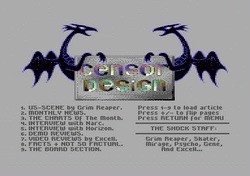
During the early 90's it became clear that the scene was going through a dramatic sense of segregation. The cracker scene was developing into two camps; one board based and one mail based. With the dramatic increase of American boards, new rules were being written. The board-based market was fast moving and circulated around speed, access to calling cards and well organized groups. "First releases" was the currency in which you paid for success. Even though "first releases" have been a key since late 1987, they were now becoming the performance indicator which groups were measured by. Propaganda, Shock and Mamba triggered this. These magazines took upon the role to document this specific market in detail. While Gamer's Guide mapped and charted the quality of the cracks (the mail scene), Shock, Propaganda and Mamba mapped and charted cracks by speed (the board scene). It is unthinkable that there even was a time when groups weren't awarded points for releases! Imagine the impact this had on competition between the groups!
The segregation between mail-based and board-based is indisputable. Do I dare say that the development of segregation on the scene could be compared to the equivalent of the rich and the poor? No speed of delivery? No calling cards? Sorry, you would not get the pot of gold on the other side of the Atlantic.

Some mail groups chose their approach to differentiate and stand out (e.g. Triad after its heyday) - but I can assure you that most groups were dying to be part of the board scene. The boards have always been a magic kingdom and a nirvana of the scene.
The segregation drew the mail-scene further away from the elite but also helped develop the legal scene; the demo scene. Naturally, there would soon be magazines focusing on these demos. Notably, this area was never an interesting media environment and these magazines were short lived without leaving a mark in history. Why? When you pick up a newspaper you will find movie reviews and book reviews. This is a way for the consumer to be able to select where to spend his 20 dollars and to make sure he's getting his money's worth.
In the scene, demos are free, and as a true scene citizen, you get them all. For free. You watch them and either you love or them or you don't. But you don't need a magazine to tell you which one was good or not because it was all free. The demos always spoken for themselves and have never needed coverage in magazines.
In addition, in between legal releases, very little would go on in a demo group. Cracker groups on the other hand were constantly changing, merging, splitting, fighting and releasing. This is why the media environment in throughout the 1990's was basically about the mail- and/or the board-scene. It was simply a happening place.
The new generation steps in With the establishment of Propaganda, Shock and some other magazines, a loyal following of readers developed. The magazine market had matured and scene citizens were starting to find their favorites magazines.
The rules of the scene had been set and for the first time ever in scene history we were in a repetitive cycle. It was becoming a tired environment.
In the early 90's (around 1992) a new generation of magazine editors entered the field. These editors had been watching the evolution of the magazine market from the way side and decided the market was ready for a more sophisticated, intellectual coverage of the scene. The magazines could be made more interesting and the readers needed to be educated. Propaganda and The Pulse led this development way ahead of competition.
I personally consider this the most interesting era of magazines in the scene. Instead of reporting news on the scene through one liner-quotes (e.g. "JFK leaves Triad" or "Opus leaves Malta"), Propaganda and The Pulse analyzed, debated and angled news for the reader. In the first year, this was a hard change for many readers. What was it? Why was there so much to read?
Both of these magazines hired top names in the scene to guarantee credibility and strength. Putting together a staff was putting together a dream team of crackers, leaders, swappers and anyone important for the profile of the magazine.
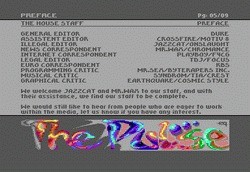
The best cracker and fixer was the perfect editor of the release charts for 2 reasons; 1) his opinion would be respected, 2) he always had interesting observations. During my development of the Propaganda magazine, we took it from an average board magazine to one delivering smart interviews, debating news and provocative articles.
We invented the annual polls, which became an academy awards of the scene. We started quoting people's statements in our news reporting. We discussed every release in detail. We had headlines and inside news of groups and people. We were the paparazzi, the digging reporters and the sensation seekers. It was a revolution.
In 2 years, Propaganda had become an institution - hated and loved. I remember the endless amount of reactions that would fill my mailboxes on the American boards, my answering machine and my e-mail when a new edition was being released. As an editor, I was victim of a lot of hatred for what was being written. But to me it was clear: Finally somebody was delivering a magazine with actual news value and the understanding in delivering an exciting read!
If the early days of Shock and Mamba were the development of a following and loyal readership, the new era took it to the extreme. Readers would become extremely loyal to their magazine. "What magazine do you read?", "I get my information from Propaganda", "I read only The Pulse because I believe more in its sources", or "I read them all to create my own opinion about what's going on". These were common discussions on the American boards. Magazines were as discussed as releases or groups.
I believe that the latter statement was correct if you really wanted to grasp what happening on the scene - you had to read it all to make a fair judgment. Like in our real world, TV shows, newscasts and newspapers cover stories with different angles and for different purposes. So did the media of the scene. The Taliban regime may be covered in a certain way in Western media but not in Muslim countries. Alpha Flight may have been under the magnifying glass in Propaganda while F4CG was under the magnifying glass in Relax. We weren't out there to be liked. We were out there to give entertainment.
Propaganda was the preferred magazine on the boards and The Pulse was preferred by the mail scene. We were both leaders. Being a leader is difficult, but following the success of others is easy. Just follow the butt moving in front of you. Among the butt followers, we saw for instance Relax (AFL). They were competitive but lacked an edge to make them part of history.
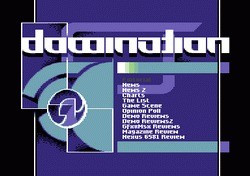
The evolution of magazines had taken us to a time where the magazines were also brands with a value and a meaning to the mind set of the reader. Gone were the poorer standards of editorial and the ones that existed did not receive a loyal following.
In the mid-90's (94 or so), two productions from relatively new sceners were paving way for a new type of media. They were Vandalism News and Domination. I call them mega magazines because they leave nothing out. They feed you legal and illegal news, articles, demo review, cracker charts, demo charts. It's one stop shopping of everything you need to know. Maybe this was because the scene has become so small that everything can be covered and serviced through one source? Is this a sign that its editors are trying to grab every piece of the pie in appealing every target group of readership? Is this because the market is so mature that there are not enough players to release good reporting magazines?

I personally believe that mega magazines were a sign that the Commodore 64 scene was coming towards the end of its cycle. Much like the product life cycle I mentioned earlier. The 64 scene has already been replaced by new scenes and environments. BUT - the machine will always a have a following and a fan base. It will always be the attention of nostalgia for as long as we want to keep the memories alive.
Therefore there will always be a need for documentation and reporting. A magazine like Domination or a similar zine will always circulate. It may change form, shape and content.
The Internet did not change much about the Commodore 64. Releases will still be releases. Demos will still be demos. It did however change the environments for the magazines. News today travels at the speed of light. Who needs a magazine that reports one-liner news today? Who needs non-analytic coverage?
It is clear that the Internet has opened doors to new types of media; a) trying to cover it all (Vandalism News)) and b) to debate, angle and analyze. I hope Recollection and Vandalism take this to their hearts and continue the legacy. As you know by now, you have to differentiate or die.
Biography:
Newscopy started his career in the scene in 1982 on the VIC20 and moved on to the Commodore 64 in 1984.
He has been organizing or helped organizing groups like The Silents, Exact, Vision, Genesis Project and F4CG. His contributions have mainly been organizational and supplying first releases. Newscopy was one of the frequent visitors and debating contributors of the American board scene.
Newscopy took over the editorial position of Propaganda from Antichrist/G*P. When Genesis*Project died, Newscopy converted Propaganda to an independent production. He was editor during the years 1993-98. In 1998, with the last release of Propaganda ever, Propaganda was on the top of the charts in 6 magazines.
Newscopy left the scene in 1998 and is a marketing director for one of Sweden's largest companies. He specializes in brand and marketing strategies and PR. He travels some 200 days a year but welcomes people to stay in touch with him at per.jacobsson@skf.com




















